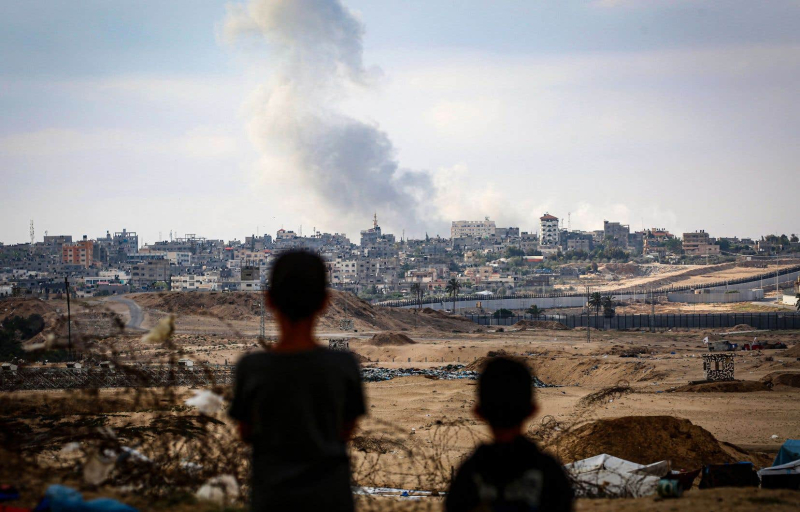
Photo: Agence France-Presse Boys watch smoke rising from a building following Israeli army airstrikes in Rafah on Monday.
France Media Agency to Rafah
Posted at 9:31 a.m.
- Middle East
Violent fighting pitted the Israeli army against Hamas on Monday in the Gaza Strip, particularly in Rafah, despite warnings from the United States against a major offensive in this overpopulated city and the risk of “anarchy” in the Palestinian territory .
AFP correspondents and witnesses report violent clashes between Israeli soldiers and Hamas fighters in different sectors of Gaza, at a time when Israel is preparing to celebrate the 76th anniversary of its creation, overshadowed by more than seven months of war in the Palestinian territory.
A little less than a week after the start of the Israeli army's incursion into Rafah, a town on the Egyptian border in the south of the Gaza Strip where 1.4 million Palestinians are crowded together, the secretary of US State Secretary Antony Blinken said a major offensive in the crowded city would not achieve Israel's goal of eliminating Hamas.
Also read
- No respite in strikes in Gaza, UN criticizes Israel's maneuvers
- At the UN, Palestinians receive massive but symbolic support for their membership
- Canada chooses to abstain on Palestinian membership in the UN
AFP correspondents reported helicopter fire and bombings in eastern Rafah, a town where Israeli Prime Minister Benjamin Netanyahu is threatening to launch a major ground offensive to attack the last Hamas battalions sheltering there, according to him.
Risk of “chaos”
Fighting between Israeli forces and Palestinian militants has raged in recent days also in the northern Gaza Strip, where, a few months after declaring that the Hamas command structure had been dismantled, an army spokesperson Israeli government said Hamas was “trying to rebuild its military capabilities.”
Last week, Israeli forces ordered the population to evacuate eastern Rafah and 300,000 Palestinians followed these calls, according to the army. These calls were renewed on Monday, according to witnesses.
But in the eyes of Mr. Blinken, a vast operation in Rafah would risk creating “chaos”, “the anarchy” and “enormous damage” to the civilian population “without solving the problem” of Hamas.
“We have seen Hamas return to the areas that Israel liberated in the north, even to Khan Yunis,” a ruined town near Rafah, he said in an interview with NBC.
“No safe place in Gaza”
On foot, in vehicles or of tricycles, Palestinians continue to flee Rafah to try to find refuge elsewhere in the Palestinian territory.
“We lived through hell for three days and the worst nights since the start of the war,” Mohammed Hamad, 24, who fled east of Rafah, targeted by bombings, told AFP.
The branch Hamas army claimed responsibility for shelling Israeli soldiers and vehicles near the Rafah crossing.
“Israeli authorities continue to issue forced displacement orders […]. This forces the residents of Rafah to flee anywhere,” wrote the head of the UN agency for Palestinian refugees (UNRWA), Philippe Lazzarini, on the social network
“Talk about safe zones is false and misleading. No place in Gaza is safe” for its approximately 2.4 million residents, he said.
In attacking Israeli Prime Minister Rafah wants to “derail” talks on a truce and the release of hostages held in Gaza, Hamas accused on Sunday.
The Islamist movement claimed to have accepted a proposal mediators – Egypt, Qatar, United States – on a truce, but Israel responded that the accepted proposal was “far from [its] demands”.
On the verge of “collapse”
The war was sparked by the October 7 attack by Hamas commandos infiltrated from Gaza in southern Israel, which left more than 1,170 dead, mostly civilians, according to an AFP report based on data Israeli officials. More than 250 people were kidnapped during the attack and 128 remain captive in Gaza, of whom 36 are believed to have died, according to the army.
In response, the army launched intense bombardments followed by a ground offensive on October 27, which ravaged Gaza, displaced the majority of the population and caused a humanitarian catastrophe with an imminent threat of famine, according to the UN, and a heavy human toll: 35,091 deaths, the majority civilians according to the Hamas Ministry of Health.
The latter warned on Monday that the Palestinian territory's healthcare system was “hours away from collapse” for lack of fuel to operate hospital generators, ambulances and staff transport. »
The Israeli army has reported the deaths of 272 of its soldiers since the start of the ground offensive.
After sounding for the first time on Sunday evening in Israel to mark the start of the annual commemorations for the soldiers who fell in defense of the country and the victims of attacks, the sirens sounded again on Monday at 11:00 a.m. ( 4:00 a.m. in Quebec), followed by a series of ceremonies at Israel's military cemeteries.
Festivities to celebrate the 76th anniversary of the establishment of the State of Israel, which are to begin Monday evening, are overshadowed by the war in Gaza.
On May 15, the Palestinians must commemorate the Nakba, (“catastrophe” in Arabic) which for them evokes the exodus of 760,000 people during the 1948 war after the creation of the State of Israel.
In addition, the Lebanese Islamist movement Hezbollah, an ally of Hamas, announced on Monday that it had targeted a military position in northern Israel, bordering Lebanon.< /p>
“Two anti-tank missiles” fell in this area, injuring four soldiers, the Israeli army said.

